Poroubalous (talk | contribs) m →References: added two references |
Poroubalous (talk | contribs) m →See also: added another reference |
||
| Line 135: | Line 135: | ||
*"[http://select.nytimes.com/gst/abstract.html?res=F40614FC395A107B93CBA81789D95F478585F9 Sitting Bull Rises Again - Two Indians Deny Bones of Chief Were Taken to South Dakota.]" ''The New York Times.'' Dec. 19, 1953. |
*"[http://select.nytimes.com/gst/abstract.html?res=F40614FC395A107B93CBA81789D95F478585F9 Sitting Bull Rises Again - Two Indians Deny Bones of Chief Were Taken to South Dakota.]" ''The New York Times.'' Dec. 19, 1953. |
||
*"[http://select.nytimes.com/gst/abstract.html?res=FA0D15F63E55107B93CBA9178FD85F478585F9 Bones of Sitting Bull Go South From One Dakota to the Other.]" ''The New York Times.'' April 9, 1953. |
*"[http://select.nytimes.com/gst/abstract.html?res=FA0D15F63E55107B93CBA9178FD85F478585F9 Bones of Sitting Bull Go South From One Dakota to the Other.]" ''The New York Times.'' April 9, 1953. |
||
*"[http://select.nytimes.com/2007/01/28/us/28thisland.html Restoring Dignity to Sitting Bull, Wherever He Is.]" ''The New York Times.'' Jan. 28, 2007. |
|||
*{{wikicite|id=idPrairiePublic|reference=Prairie Public Radio. ''Dakota Datebook.'' Sept. 3, 2004. Available online at http://www.pol.org/programs/datebook/bydate/04/0904/090304.jsp}} |
*{{wikicite|id=idPrairiePublic|reference=Prairie Public Radio. ''Dakota Datebook.'' Sept. 3, 2004. Available online at http://www.pol.org/programs/datebook/bydate/04/0904/090304.jsp}} |
||
*{{wikicite|id=idUSPS|reference=United States Postal Service, Postal History Web site. Available online at http://www.usps.com/postalhistory/_rtf/AmerInd.rtf}} |
*{{wikicite|id=idUSPS|reference=United States Postal Service, Postal History Web site. Available online at http://www.usps.com/postalhistory/_rtf/AmerInd.rtf}} |
||
| Line 142: | Line 143: | ||
</div> |
</div> |
||
===Primary sources=== |
|||
<div class="references-small"> |
|||
| ⚫ | |||
| ⚫ | |||
| ⚫ | |||
| ⚫ | |||
| ⚫ | *Reno, Marcus Albert. ''The official record of a court of inquiry convened at Chicago, Illinois, January 13, 1879, by the President of the United States upon the request of Major Marcus A. Reno, 7th U.S. Cavalry, to investigate his conduct at the Battle of the Little Big Horn, June 25-26, 1876.'' Pacific Palisades, Calif.: 1951. Available online at http://digital.library.wisc.edu/1711.dl/History. |
||
</div> |
|||
===Further reading=== |
===Further reading=== |
||
<div class="references-small"> |
<div class="references-small"> |
||
| Line 158: | Line 150: | ||
*Greene, Jerome A., ed. ''Lakota and Cheyenne: Indian Views of the Great Sioux War, 1876-1877.'' Norman, Okla.: Univ. of Oklahoma Press, 1994. |
*Greene, Jerome A., ed. ''Lakota and Cheyenne: Indian Views of the Great Sioux War, 1876-1877.'' Norman, Okla.: Univ. of Oklahoma Press, 1994. |
||
*Manzione, Joseph. ''"I Am Looking to the North for My Life": Sitting Bull: 1876-1881.'' Salt Lake City: Univ. of Utah Press, 1991. |
*Manzione, Joseph. ''"I Am Looking to the North for My Life": Sitting Bull: 1876-1881.'' Salt Lake City: Univ. of Utah Press, 1991. |
||
| ⚫ | |||
| ⚫ | |||
| ⚫ | |||
| ⚫ | |||
| ⚫ | *Reno, Marcus Albert. ''The official record of a court of inquiry convened at Chicago, Illinois, January 13, 1879, by the President of the United States upon the request of Major Marcus A. Reno, 7th U.S. Cavalry, to investigate his conduct at the Battle of the Little Big Horn, June 25-26, 1876.'' Pacific Palisades, Calif.: 1951. Available online at http://digital.library.wisc.edu/1711.dl/History. |
||
*Sifakis, Stewart. ''Who's Who In The Civil War.'' New York: Facts on File Publishing, 1988. |
*Sifakis, Stewart. ''Who's Who In The Civil War.'' New York: Facts on File Publishing, 1988. |
||
*Urwin, Gregory. ''Custer Victorious: The Civil War Battles of General George Armstrong Custer.'' Lincoln, Neb.: Univ. of Nebraska Press, 1990. |
*Urwin, Gregory. ''Custer Victorious: The Civil War Battles of General George Armstrong Custer.'' Lincoln, Neb.: Univ. of Nebraska Press, 1990. |
||
Revision as of 01:27, 12 December 2007
Sitting Bull | |
|---|---|
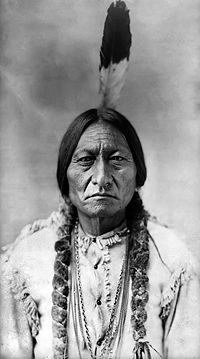 Sitting Bull in 1885 | |
| Born | Jumping Badger, later Sitting Bull c. 1831 Near the Grand River, South Dakota |
| Died | December 15, 1890 |
| Nationality | Lakota Sioux |
| Other names | Slow, Jumping Badger |
| Occupation(s) | holy man, war chief |
| Height | 5 ft 10 in (178 cm) |
| Children | One Bull, son |
| Parent(s) | Sitting Bull (Jumping Bull), father Her-Holy-Door, mother |
| Relatives | Big Foot, half brother White Bull, nephew |
| Signature | |
| File:Sittingbullsignature.jpg | |
Sitting Bull (Sioux: Tatanka Iyotake, Tatanka Iyotanka or Ta-Tanka I-Yotank, first nicknamed Slon-he, ("Slow")), (ca. 1831 – December 15, 1890) was a Hunkpapa Lakota Sioux holy man, born near the Grand River in South Dakota and killed by police on the Standing Rock Indian Reservation during an attempt to arrest him.
He is notable in American and Native American history for his role in the major victory at the Battle of the Little Bighorn against Lt. Col. George Armstrong Custer and the U.S. 7th Cavalry Regiment on June 25, 1876, where Sitting Bull's premonition of defeating them became reality. In the months after the battle, Sitting Bull fled the United States to Canada, where he remained until 1881, at which time he surrendered to American forces. After his return to the United States, he briefly toured as a performer in Buffalo Bill's Wild West Show, where he befriended Annie Oakley.
After working as a performer, Sitting Bull returned to the Standing Rock Agency in South Dakota. Because of fears that he would use his influence to support the Ghost Dance movement, Indian Affairs authorities authorized his arrest. During a struggle between his followers and police, he was killed by the police. His body was taken to nearby Fort Yates for burial, but in 1953, his remains possibly were exhumed and reburied near Mobridge, South Dakota.
Early life
Childhood
Sitting Bull was born with the name Jumping Badger, which was understood by members of his tribe as only a temporary name.[1] His deliberate pace and way of life gave him the nickname Hunkesni, or Slow.[2] His father was named Sitting Bull (who he would later be named after), his mother was named Her-Holy-Door, and he had a sister, six years older than him, named Good Feather. As a youth, Slow excelled at foot races, games, and was an expert horseback rider and was very accurate with bow and arrow.[3]
At about the age of 14, Slow participated in a a war party that met Crow warriors.[4] He overtook one of the warriors during their retreat, and knocked the Crow off his horse. For this, Slow earned a white eagle feather, symbol of a first coup, and also received the name of his father. His father changed his name to Jumping Bull, and henceforth Slow would be known as Tatanka-Iyotanka, or Sitting Bull.[5] It was also at this ceremony that Sitting Bull received his shield.
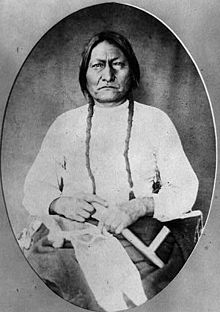
Early adulthood
As Sitting Bull grew, he participated in more war parties, gaining a red feather that signified a battlefield wound.[6] He performed feats of bravery, and became expert in other weapons such as the knife, tomahawk, war club, and was competent with firearms. He favored the use of the lance, which was also presented to him by his father.[7]
In 1856, Sitting Bull again was wounded in combat by a Crow warrior who shot Sitting Bull in the foot. The wound caused Sitting Bull to limp for the rest of his life.[8]
Sitting Bull's bravery gained him access to Sioux warrior societies such as the Kit Fox and the Strong Heart, the latter of which was highly prestigious.[9] Sitting Bull and other warriors in the Strong Heart society (such as Chief Gall and Crow King) founded an elite society within the Strong Heart called the Midnight Strong Heart Society.[10] In 1857, the Midnight Strong Heart Society made Sitting Bull a war chief, and later that year, he was according the same status in the Hunkpapa tribe.[11]
Marriage and family
Sitting Bull's early family history is not clear, but his first marriage likely took place in 1851 to a woman named Pretty Door or Light Hair.[12] By 1857, Sitting Bull's marriage to Light Hair produced a son (who died of disease at a young age), but Light Hair died during childbirth. Sitting Bull adopted his nephew, One Bull, at the time of his biological son's death. Also in 1857, Sitting Bull adopted a young Assiniboine as his brother, and he came to be known as Jumping Bull (a tribute to Sitting Bull's father).[13]
Status as holy man
Sitting Bull became a Sioux holy man, or wichasha wakan, during his early twenties. His responsibilities as a holy man included understanding the complex religious rituals and beliefs of the Sioux, and also learning about natural phenomena that were related to the Sioux beliefs. Sitting Bull had an "intense spirituality that pervaded his entire being in his adult years and that fueled a constant quest for an understanding of the universe and of the ways in which he personally could bring its infinite powers to the benefit of his people."[14] However, Sitting Bull also knew techniques of healing and carried medical herbs, though he was not a medicine man.
Because of his status as a wichasha wakan, Sitting Bull was a member of the Buffalo Society, a dream society for those who dreamt of buffalo, and he also was a member of the Heyoka, a society for those who dreamt of thunderbirds.[15]
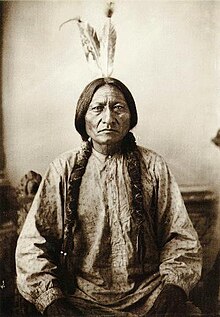
Warrior life
Dakota War of 1862 and its aftermath
Although the Lakota largely were unaffected by the Dakota War of 1862, some Dakota refugees from Minnesota moved into Lakota territory along the Missouri River, and Minnesota regiments pursued them. In 1863, Hunkpapa warriors (probably including Sitting Bull) joined with Dakota refugee warriors to fight against the military. However, Col. Henry Sibley defeated them at the Battle of Dead Buffalo Lake on July 26 and at the Battle of Stony Lake on July 28.[16] Sitting Bull also possibly took part among other Hunkpapa warriors in the Battle of Whitestone Hill, on September 3. Again, the Army prevailed, killing about 100 Sioux and capturing about 160.[17][18]
The Hunkpapa retreated after this defeat, though the Lakota were aware of the military's intentions to continue the fighting. In June 1864, Gen. Alfred Sully led American forces out from Fort Sully (a few miles south of Fort Pierre, South Dakota). To counter their advance up the Cannonball River, several bands of the Lakota and Dakota Sioux had assembled in camp at the foot of the Kildeer mountains. Among these several thousand warriors were both Sitting Bull and his elder nephew White Bull, who was preparing to fight in his first battle.[19]
At the Battle of Killdeer Mountain, which took place July 28, 1864, the Sioux attacked Sully's assembled forces, but were defeated overwhelminingly by the soldiers' combined artillery and rifles. Sitting Bull's uncle, Four Horns, was wounded though survived, and the Sioux retreated. However, they attacked Sully's forces again from August 7 to August 9, 1864, and were defeated again. Sitting Bull made efforts to persuade the Sioux forces to withdraw, and as a result of his pleas and Sully's second victory, the Sioux pulled back from attacking Sully's column as it continued through the Badlands.[20] The several bands broke up after Kildeer Mountain, and Sitting Bull and a group of Hunkpapas moved southeast.
On September 2, 1864, Sitting Bull and the Hunkpapas attacked a wagon train of emigrants led by Capt. James L. Fisk that was travelling through Sioux lands.[21] Sitting Bull again was wounded, this time through the hip and back. The emigrants forted up and a standoff ensued until the Sioux eventually gave up and retreated to track buffalo. The fighting from 1863 to 1864 caused Sitting Bull to harden his views about the presence of whites in Sioux lands, and he assumed a sense of uncompromising militancy against whites that would characterize him for the rest of his life.[22]
Red Cloud's War
Sitting Bull led numerous war parties against Fort Berthold, Fort Stevenson, and Fort Buford and their environs from 1865 through 1868.[23] Although Red Cloud was a leader of the Oglala Sioux, his leadership and attacks against forts in the Powder River Country were accompanied by Sitting Bull's guerilla attacks on emigrant parties and smaller forts throughout the upper Missouri River region.
By early 1868, the U.S. government desired a peaceful settlement to Red Cloud's War, and agreed to Red Cloud's demands that Forts Phil Kearny and C.F. Smith be abandoned. Chief Gall of the Hunkpapas (among other representatives of the Hunkpapas, Blackfeet, and Yankton Sioux) signed a form of the Treaty of Fort Laramie on July 2, 1868 at Fort Rice (near Bismarck, North Dakota).[24] However, Sitting Bull did not agree to the treaty and continued his hit-and-run attacks on forts in the upper Missouri area throughout the late 1860s and early 1870s.[25]
Black Hills War

Sitting Bull's band of the Hunkpapas continued to make attacks on emigrant parties and forts in the late 1860s, but in 1871, the Northern Pacific Railway conducted a survey for a route across the northern plains directly through Hunkpapa lands.[26] The 1871 survey encountered stiff Sioux resistance, and in 1872, the surveyors were accompanied by federal troops. This survey party also was resisted by Sitting Bull and the Hunkpapa, and was forced to turn back. In 1873, the military accompaniment for the surveyors was considerably larger, but Sitting Bull's forces resisted this survey "most vigorously."[27]
However, the Panic of 1873 forced the backers (such as Jay Cooke) of the Northern Pacific Railway's into bankruptcy. This halted the construction of the railroad through Sioux territory, but also encouraged interest in the possibility of gold mining in the Black Hills. A military expedition led by Lt. Col. George Armstrong Custer in 1874 left from Fort Abraham Lincoln, near Bismarck, to explore the Black Hills for gold and to determine a suitable location for a military fort in the Hills.[28] Custer's announcement of gold in the Black Hills triggered the Black Hills Gold Rush and increased tensions between the Sioux and whites seeking to move into the Black Hills.
Although Sitting Bull did not attack Custer's expedition in 1874, the government was increasingly pressured to open the Black Hills to mining and settlement based on reports of Sioux depredations (encouraged by Sitting Bull). In November 1875, the government accordingly ordered all Sioux bands outside the Great Sioux Reservation to move onto the reservation, with the knowledge that these bands would not comply. These bands living off the reservation were certified by the Interior Department as hostile on February 1, 1876.[29] This certification allowed the military to pursue the Sioux and Sitting Bull.
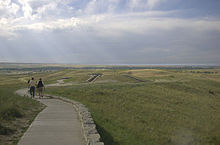
Battle of Little Bighorn
Lt. Col. Custer, a decorated Union veteran of the Civil War, was an ambitious military officer with presidential hopes in the early 1870s. His Civil War exploits and his presence at Lee's surrender at Appomattox had made Custer a household name by the time he began his career fighting the Sioux. He was well-known among Native Americans and his fame among whites grew ever-larger as the result of a series of controversial battles and early dawn attacks against Native American camps.
Sitting Bull's influence, growing since his days as a young man, was growing larger as a result of his militant stance against white intrusions on Sioux lands. By the mid-1870s, Sitting Bull had garnered great respect even among other bands of the Sioux, while his guidance also impacted the Northern Cheyenne and the Northern Arrapahoes.[30]
On June 25, 1876, Custer’s 7th Cavalry advance party of General Alfred Howe Terry’s column attacked Indian tribes at their camp on the Little Big Horn River expecting a similar victory. The U.S. army did not realize that before the battle began, more than 3,000 Native Americans had left their reservations to follow Sitting Bull. The attacking Sioux, inspired by a vision of Sitting Bull’s, in which he saw U.S. soldiers being killed as they entered the tribe’s camp, fought back.
Custer's badly-outnumbered troops lost ground quickly and were forced to retreat, as they began to realize the true numbers of the Native American force. The tribes then led a counter-attack against the soldiers on a nearby ridge, ultimately annihilating the soldiers.
The victory placed Sitting Bull among the great Native American leaders such as fellow Little Big Horn veteran Crazy Horse and Apache freedom fighter Geronimo. But the Native Americans' celebrations were short lived, as public outrage at the military catastrophe and Custer's death and its heightened wariness of the remaining Native Americans brought thousands more cavalrymen to the area. Over the next year, the new forces relentlessly pursued the Lakota, forcing many of the Indians to surrender. Sitting Bull refused to surrender and in May 1877 led his band across the border into Saskatchewan, Canada where he remained in exile for many years near Wood Mountain[31], refusing a pardon and the chance to return.

Surrender
Hunger and cold eventually forced Sitting Bull, his family, and a few remaining warriors to surrender on July 19, 1881. Sitting Bull had his son and his rifle to the commanding officer of Fort Buford, telling the soldiers they had come to regard them and the white race as friends.
Two weeks later, Sitting Bull and his band were transferred to Fort Yates, the military post located adjacent to the Standing Rock Agency. Arriving with 185 people, his band was kept separate from the other Hunkpapa gathered at the agency. Army officials remained concerned that the famed Hunkpapa chief would use his influence to stir up trouble among the recently surrendered northern bands and consequently, they decided to transfer him and his band to Fort Randall to be held as prisoners of war. Again loaded on a steamboat, Sitting Bull's band, totaling 172 people, were sent downriver to Fort Randall where they spent the next 20 months. He was finally allowed to return to the Standing Rock Agency with his band, arriving in May 1883.

Fame
In 1885, Sitting Bull was allowed to leave the reservation to join Buffalo Bill Cody’s Wild West Show. He earned about $50 a week for riding once around the arena, where he was a popular attraction. Although it is rumored that he often cursed his audiences in his native tongue to the wild applause of his listeners, some historians argue that he did not,[32] and there have been reports that Sitting Bull in fact gave speeches relaying his desire for education for the young and the normalization of relations between the Sioux and whites.[33] Sitting Bull also was reported to have cursed his audience during an opening address celebrating the completion of the Northern Pacific Railway in 1884.[34]
Sitting Bull only stayed with the show for four months before returning home. However, during that time, he had become somewhat of a celebrity and a romanticized freedom fighter. He earned a small fortune by charging for his autograph and picture. It is rumored that Sitting Bull also once shook hands with President Grover Cleveland.
In his trips throughout the country, Sitting Bull realized that his former enemies were not limited to the small military and settler communities he had encountered in his homelands, but were in fact a large and highly-advanced society. He realized that the Sioux would be overwhelmed if they continued to fight.

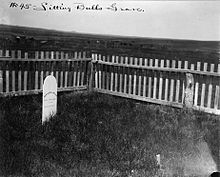
Death
Back at Standing Rock, Sitting Bull became associated with the Ghost Dance movement. Although it has not been proven that he joined, he allowed others in the tribe to do so. The movement's followers believed performing the ghost dance would sweep away all evil in the world, including the white man and his society, bring back the deceased reuniting them with the living, and hasten a time of love and prosperity.
Indian Affairs authorities feared that Sitting Bull, as a popular spiritual leader, would give more credibility to the movement and decided to arrest him. Pre-empting the army, 43 Indian police attempted to arrest him at his cabin on December 15, 1890, at the Standing Rock Agency. Initially, Sitting Bull did not resist the arrest; however, some of his followers fought to prevent it, fearing that the army meant to kill him. As Sitting Bull exited his cabin, about 150 of these followers had assembled.[35]
One of Sitting Bull's followers, Catch-the-Bear, fired a shot at one of the police officers standing next to Sitting Bull, Lt. Bull Head, who then shot Sitting Bull in the side. Another police office, Sgt. Red Tomahawk, then shot Sitting Bull in the head, killing him. Another officer, Sgt. Shave Head, also was shot by Sitting Bull's followers, and fell with Sitting Bull and Bull Head. Shortly after, Catch-the-Bear was killed by another Indian police officer.[36]
In the end, six police officers were killed, and one other wounded, while seven of Sitting Bull's followers were killed in the fighting, including his 17-year-old son Crow Foot. [37]
Sitting Bull's body was taken by the Indian police to Fort Yates, North Dakota, and buried outside the military cemetery there. His surviving wives, Four Robes and Seen-By-Her-Nation along with their children fled to the community of Red Shirt Table in the Badlands, South Dakota after being detained at Fort Yates.
Some Lakota claim that his remains were transported on the night of April 8, 1953 to an open field near Mobridge, South Dakota, and a granite shaft and a bust by sculptor Korczak Ziółkowski mark the location.[38] However, the actual location of Sitting Bull's body was and still is disputed.[39][40]
Legacy
Following his death, his cabin on the Grand River was taken to Chicago to become part of the 1893 Columbian Exhibition. The cabin was exhibited along with Native American dances and a sign that said "War Dance Given Daily."[41]
Later, Sitting Bull became the subject of or a character in several Hollywood motion pictures, such as Sitting Bull: The Hostile Sioux Indian Chief (1914), Sitting Bull at the Spirit Lake Massacre (1927), Sitting Bull (1954), and Buffalo Bill and the Indians, or Sitting Bull's History Lesson (1976).
As time passed, Sitting Bull's legacy became a product of the public's lasting perception of him as an archetype of Native American resistance movements. Legoland Billund, the first Legoland park, contains a Lego sculpture of Sitting Bull, which is the largest sculpture in the park. On September 14, 1989, the United States Postal Service released a postage stamp featuring a likeness of Sitting Bull with a denomination of 28¢.[42] On March 6, 1996, the Standing Rock Sioux tribal council voted to rename Standing Rock College (formerly Standing Rock Community College) as Sitting Bull College in honor of Sitting Bull.
See also
Footnotes
- ^ Utley 1993, p.5.
- ^ Utley 1993, p.6.
- ^ Utley 1993, p.10.
- ^ Utley 1993, p.14-5.
- ^ Utley 1993, p.15.
- ^ Utley 1993, p.13.
- ^ Utley 1993, p.19.
- ^ Utley 1993, p.21.
- ^ Utley 1993, p.18.
- ^ Utley 1993, p.18.
- ^ Utley 1993, p.22.
- ^ Utley 1993, p.20.
- ^ Utley 1993, p.24.
- ^ Utley 1993, p.27.
- ^ Utley 1993, p.29.
- ^ Utley 1993, p.52-3.
- ^ Utley 1993, p.53.
- ^ Prairie Public Radio, 2004.
- ^ Utley 1993, p.55.
- ^ Utley 1993, p.58-9.
- ^ Utley 1993, p.62-3.
- ^ Utley 1993, p.64.
- ^ Utley 1993, p.66-72.
- ^ Utley 1993, p.80.
- ^ Utley 1993, p.82.
- ^ Utley, Frontier Regulars 1973, p.242.
- ^ Utley Frontier Regulars 1973, p.242.
- ^ Utley Frontier Regulars 1973, p.244.
- ^ Utley Frontier Regulars 1973, p.248.
- ^ Utley Frontier Regulars 1973, p.236.
- ^ Wood Mountain, Saskatchewan official site
- ^ Utley 1993, p.263
- ^ Standing Bear 1975, p.185
- ^ Lazarus 1991, p.106
- ^ Mooney 1896, p.104.
- ^ Mooney 1896, p.104-5.
- ^ Mooney 1896, p.105.
- ^ New York Times, April 9, 1953.
- ^ New York Times, Jan. 28, 2007.
- ^ New York Times, Dec. 19, 1953.
- ^ Barker 1994, p.165.
- ^ United States Postal Service, Postal History Web site
References
- Barker, Barbara. "Imre Kiralfy's Patriotic Spectacles: "Columbus, and the Discovery of America" (1892-1893) and "America" (1893)." Dance Chronicle. Vol. 17, no. 2 (1994).
- Lazarus, Edward. Black Hills White Justice: The Sioux Nation versus the United States, 1775 to the Present. New York: HarperCollins, 1991.
- Mooney, James. (Abridged version) The Ghost-Dance Religion and the Sioux Outbreak of 1890. Originally published as Part 2 of the Fourteenth Annual Report of the Bureau of Ethnology to the Secretary of the Smithsonian Institution, 1892-93, Washington: GPO, 1896. Abridged version publication information: Edited by Anthony F.C. Wallace. Chicago: Univ. of Chicago Press, 1965.
- "Sitting Bull Rises Again - Two Indians Deny Bones of Chief Were Taken to South Dakota." The New York Times. Dec. 19, 1953.
- "Bones of Sitting Bull Go South From One Dakota to the Other." The New York Times. April 9, 1953.
- "Restoring Dignity to Sitting Bull, Wherever He Is." The New York Times. Jan. 28, 2007.
- Prairie Public Radio. Dakota Datebook. Sept. 3, 2004. Available online at http://www.pol.org/programs/datebook/bydate/04/0904/090304.jsp
- United States Postal Service, Postal History Web site. Available online at http://www.usps.com/postalhistory/_rtf/AmerInd.rtf
- Utley, Robert M. The Lance and the Shield: The Life and Times of Sitting Bull. 1st ed. New York: Henry Holt and Company Inc., 1993.
- Utley, Robert M. Frontier Regulars: The United States Army and the Indian, 1866-1891. New York: Macmillan Publishing Co. Inc., 1973.
- Standing Bear, Luther. My People the Sioux. Lincoln: Univ. of Nebraska Press, 1975.
Further reading
- Adams, Alexander B. Sitting Bull: An Epic of the Plains. New York: G.P. Putnam's Sons, 1973.
- Brown, Dee. Bury My Heart at Wounded Knee: An Indian History of the American West. New York: Holt, Rinehart and Winston, 1970.
- DeWall, Robb. The Saga of Sitting Bull's Bones: The Unusual Story Behind Sculptor Korczak Ziolkowski's Memorial to Chief Sitting Bull. Crazy Horse, S.D.: Korczak's Heritage, 1984.
- Greene, Jerome A., ed. Lakota and Cheyenne: Indian Views of the Great Sioux War, 1876-1877. Norman, Okla.: Univ. of Oklahoma Press, 1994.
- Manzione, Joseph. "I Am Looking to the North for My Life": Sitting Bull: 1876-1881. Salt Lake City: Univ. of Utah Press, 1991.
- Newson, Thomas McLean. Thrilling scenes among the Indians. With a graphic description of Custer's last fight with Sitting Bull. Chicago: Belford, Clarke and Co., 1884. Available online at http://digital.library.wisc.edu/1711.dl/History.
- "Confirmation of the Disaster." The New York Times. July 7, 1876.
- "The Death of Sitting Bull." The New York Times. Dec. 17, 1890.
- "The Last of Sitting Bull." The New York Times. Dec. 16, 1890.
- Reno, Marcus Albert. The official record of a court of inquiry convened at Chicago, Illinois, January 13, 1879, by the President of the United States upon the request of Major Marcus A. Reno, 7th U.S. Cavalry, to investigate his conduct at the Battle of the Little Big Horn, June 25-26, 1876. Pacific Palisades, Calif.: 1951. Available online at http://digital.library.wisc.edu/1711.dl/History.
- Sifakis, Stewart. Who's Who In The Civil War. New York: Facts on File Publishing, 1988.
- Urwin, Gregory. Custer Victorious: The Civil War Battles of General George Armstrong Custer. Lincoln, Neb.: Univ. of Nebraska Press, 1990.
- Utley, Robert M. The Last Days of the Sioux Nation. New Haven, Conn.: Yale Univ. Press, 1963.
- Vestal, Stanley. Sitting Bull: Champion of the Sioux, a Biography. New York: Houghton Mifflin Co., 1932.
External links
- PBS The West article on Sitting Bull.
- Friends of the Little Bighorn Battlefield article about Ernie LaPointe's efforts to move Sitting Bull's remains to the Little Bighorn Battlefield
- The Sitting Bull Monument Foundation in Mobridge, South Dakota
- Yahoo News article about the contoversy about the Sitting Bull Monument Foundation's plans. (June 16,2007)
- The official website for a documentary film biography of Sitting Bull.